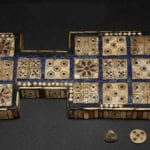 Weird Stuff
Weird Stuff  Weird Stuff
Weird Stuff  Mysteries
Mysteries 10 Tragic Disappearances and Deaths in Joshua Tree National Park
 History
History 10 Ways Childhood Really Sucked in the Old West
 Music
Music 10 Name Origins of Famous Bands from the 1990s
 Religion
Religion 10 Biggest Turnarounds by the Catholic Church
 Weird Stuff
Weird Stuff 10 Unbelievable Times Laws Had Unintended Consequences
 Humans
Humans Ten Historic Women Who Deserve Way More Credit Than They Got
 Movies and TV
Movies and TV 10 Films That Spawned Major Lawsuits
 History
History Ten Times Towns Were Wiped Off the Face of the Earth
 Creepy
Creepy 10 of the Most Disturbingly Haunted Public Houses in the UK
 Weird Stuff
Weird Stuff 10 Niche Subcultures That Are More Popular Than You Might Think
 Mysteries
Mysteries 10 Tragic Disappearances and Deaths in Joshua Tree National Park
 History
History 10 Ways Childhood Really Sucked in the Old West
Who's Behind Listverse?

Jamie Frater
Head Editor
Jamie founded Listverse due to an insatiable desire to share fascinating, obscure, and bizarre facts. He has been a guest speaker on numerous national radio and television stations and is a five time published author.
More About Us Music
Music 10 Name Origins of Famous Bands from the 1990s
 Religion
Religion 10 Biggest Turnarounds by the Catholic Church
 Weird Stuff
Weird Stuff 10 Unbelievable Times Laws Had Unintended Consequences
 Humans
Humans Ten Historic Women Who Deserve Way More Credit Than They Got
 Movies and TV
Movies and TV 10 Films That Spawned Major Lawsuits
 History
History Ten Times Towns Were Wiped Off the Face of the Earth
 Creepy
Creepy 10 of the Most Disturbingly Haunted Public Houses in the UK
Top 10 Ancient Symbols Used in Modern Contexts
In a world where roughly 6,500 different languages are currently spoken, an assortment of common symbols, emblems, and logos can often bridge the gap between cultures. Certain images, and the concepts they represent, can be easily recognized by most. However, some of the most familiar images associated with modern ideas, products, or movements come to us from our most ancient ancestors.
With a wealth of history, wisdom, and hidden meanings behind them, some of these ancient symbols convey much more than their modern contexts might suggest. Let’s look at ten symbols whose modern contexts can’t compare to their ancient origins.
Related: Top 10 Sayings With Misunderstood Origins
10 The Bluetooth Rune
It’s probably fair to say that the majority of people have come across this symbol at some point. Given that smartphones are owned by almost 92% of the world’s population, the Bluetooth symbol is likely one of the most recognizable icons of the 21st century. What few people realize, however, is that the symbol was inspired by ancient Viking runes, the written alphabet used by the Germanic people of Northern Europe in the first millennium AD.
The widely identifiable icon was created by Jim Kardach, who had been reading a historical Viking novel while developing Bluetooth wireless technology. The story featured Harold Gormsson, a king who ruled over tribes in Denmark and Norway during the Viking Age. Nicknamed Harold Bluetooth, Kardach felt that Gormsson’s endeavor to unite the Viking tribes was similar to the purpose he hoped to achieve with his new technology. The resulting Bluetooth logo combines the runic figures of “H” and “B.”
The exact origins of Viking runes are the subject of debate, but it’s possible that they came from the Etruscan alphabet. The name “rune” derives from the German root word “-run,” which means “secret” or “whisper.” Given that runes were mostly used by the wealthier members of Viking society to record moments of great importance, this name seems rather fitting![1]
9 The Celtic Harp
Also known as the Gaelic harp, this is one of the most common symbols of Ireland. As well as featuring prominently in its national imagery, coins, and uniforms, the harp is associated with numerous Irish companies, including Ryan Air and Guinness. The Celtic harp set against a green background first appeared as a symbol of Ireland in 1642 (LINK 2). This strengthened a link between the instrument and the Irish people that had been established by bards and musicians who had played it for their chieftains and kings in ancient times.
As a symbol, the Celtic harp is believed to represent, among other things, the immortality of the soul. One of the oldest musical instruments in the world, a Pictish carving on an 8th century stone cross is one of the earliest known images of the harp in Ireland. Harps are associated with St. Cecilia, the patron saint of music, and are also referenced in the Old Testament as an instrument for healing. That’s something to bear in mind when knocking back a pint of Guinness ale.[2]
8 The Rod of Asclepius
A global symbol of healthcare and medicine, the Rod of Asclepius is an internationally recognized representation of the medical profession. The symbol portrays a serpent coiled around a staff, traditionally represented by a knotty tree limb. It is associated with the Greek Demigod Asclepius, who was renowned for his powers of healing and unrivaled medical aptitude. According to mythology, he received this wisdom from the whisperings of snakes. The relevance of Asclepius is even reflected in the original Hippocratic Oath. This began with the invocation, “I swear by Apollo the Healer and by Asclepius ….”
The significance of the image as representative of the art of healing is tied with the symbolism of both the staff and the snake. Traditionally, the rod has been depicted as a symbol of authority, while the serpent signifies rebirth, rejuvenation, and revitalization. The snake also represents the dual nature of the medical profession, which involves both life and death, as its venom can be fatally poisonous but also possesses medicinal properties. Keep an eye out for this one the next time you see an ambulance drive by![3]
7 The Alphabet
Perhaps one of the most obvious examples on this list, the modern western alphabet derives, of course, from ancient Greek alphabetic writing. Emerging sometime around 800 BC, the Greek alphabet was the world’s first fully phonetic alphabetic script. There were actually several regional and local variations. However, the ancient Greeks still acknowledged the immediate source by referring to their alphabets as “Phoenician letters.” The Phoenicians were the peoples occupying the regions in what is now Lebanon and parts of Syria and Israel.
Of all the local variations, it was the Ionic alphabet that was eventually adopted by Athens in classical Greece. This alphabet contained 24 letters and eventually became dominant across the Greek-speaking world. Given the reach and influence held by ancient Greece, later to be replaced by the Roman empire, it’s unsurprising that its alphabet seeped its way into the alphabetic systems of most of Europe.[4]
6 The Swastika
Since the early 1920s, the swastika has become a symbol associated with hatred and fear. Adopted as an emblem of the Third Reich, the Nazi’s redesign of this auspicious and sacred symbol has led to it being reviled by the West. The swastika served as a holy symbol in Asia for millennia and maintains its immense spiritual significance today. To Buddhists, it represents the footprints of the Buddha. The Jains regard it as one of the 24 Tirthankara saviors, while Hindus see the right-hand swastika as a sign of Surya (the Sun) and auspiciousness. They view the left-hand version, the sauvastika, as symbolic of the night and the goddess Kali. The word swastika itself derives from the Sanskrit svastika, meaning “conducive to well-being.”
The swastika as a spiritual symbol has also been found all over the world, appearing in several cultures across northern Africa, as well as the Mayan, Aztec, and Kuna civilizations of South and Central America. It was also adopted by numerous First Nation groups of North America, including the Hopi, Navajo, and Passamaquoddy. It’s also seen throughout Europe, where the first known example dates back some 15,000 years. It was used by Celtic, Vinca, Greek, and Roman cultures. The discovery in the 1870s of some 1,800 depictions of the symbol at Hisarlik, Turkey, led to its association with luck and success by the beginning of the 20th century. Around this time, German nationalists began to favor it, culminating in Hitler’s adoption of the swastika as a symbol of the burgeoning Nazi movement.[5]
5 The Star and Crescent
Today, the star and crescent is used as a national symbol for numerous countries, including Turkey, Algeria, Tunisia, Pakistan, and Malaysia. Featured on the flag of the Ottoman-Turks, it gained prevalence as a symbol of the Ottoman Empire after 1757. Its use in mosques and minarets also led to the association of the star and crescent with Islam.
The star and crescent’s origins may partially stem from long-established Mesopotamian iconography. Here, the crescent was associated with the moon god Sin and the star with the goddess Ishtar, who represents Venus. However, the symbol in its current form was likely developed in the Greek colony of Byzantium around 300 BC. Within this context, it represented the moon and the goddesses Luna and Diana, with the morning star also associated with Venus.[6]
4 The Shamrock
With a name derived from the Irish word “seamróg” or “seamair óg,” which translates as little clover, the shamrock is another of Ireland’s most recognizable emblems. Its depiction can be seen everywhere on the Emerald Isle. As an image of a three-leafed clover, it is traditionally rooted in the holy trinity symbolism of the Father, the Son, and the Holy Spirit. The patron saint of Ireland, St. Patrick, is purported to have used the shamrock in his teachings to convert the people of Ireland to Christianity in the 5th century.
What few realize is that the sacred trinity symbolism of the shamrock dates back even further than the teachings of St. Patrick. The symbol was originally associated with the Celtic earth-mother goddess Danu. Possibly a deity of fertility, wisdom, and the wind, the three leaves are believed to have represented her status as the maiden, the mother, and the crone of Ireland. Just don’t get it confused with the four-leafed clover, which has an entirely different meaning![7]
3 The Fleur-de-Lis
The fleur-de-lis symbol is used today in all manner of contexts as a purely decorative element, as well as a representation of light, life, and perfection. However, it is most commonly found in Catholic emblems. It symbolizes the Holy Trinity and purity and is ascribed to the Virgin Mary. While also appearing as a decorative feature across numerous European nations, it has most frequently been seen in France. In fact, the symbol has come to closely represent French royalty, with legend claiming that an angel presented one to Clovis, the Merovingian king of the Franks.
Translating in English to “flower of the lily,” the fleur-de-lis is believed to depict a stylized lily or lotus flower and has been used in the artworks of some of the earliest civilizations. Utilized for both ornamental and symbolic purposes, the fleur-de-lis has been found on Mesopotamian cylinders, Mycenean pottery, Egyptian bas-reliefs, Sassanid textiles, Gaulish and Mameluk coins, Japanese emblems, Indonesian clothing, and Dogon totems. It has often been associated with the sacred goddesses of these cultures.[8]
2 The Skull and Crossbones
A symbol comprised of a human skull with two long bones crossed beneath, the skull and crossbones has come to represent poison, danger, and warnings, as well as toughness and ferocity. Most commonly used today to demarcate toxic substances unfit for consumption, it has also been used as an emblem for pirates and, even today, as the insignia for numerous military and naval services throughout the world. However, this symbol has often been found in antiquity to convey a meaning termed in Latin by the Medieval intellectuals of Europe as “Memento Mori”: Remember, you are mortal.
The original meaning of the symbol was to act as a reminder of the temporary and transient nature of human life and the inevitability of death. It was used to prompt one to remember that there is eternal life within each of us and to strive to reach advanced spiritual heights. The image taught that, although death may come, the soul transcends the demise of all that is physical.[9]
1 The Black Sun
Another spiritual symbol hijacked by the Nazis, the Black Sun has been associated with the Third Reich since the 1930s. The specific configuration used by the Nazis was first utilized at Wewelsburg Castle following renovations by Heinrich Himmler. The Nazi’s own particular design was a new and unique take on various ancient representations of the “Sun Wheel” symbol. It is composed of twelve Sig-runes, which represented victory to the Nazis and was their recreation of the Viking Sowilo-rune.
The number twelve is highly significant in various spiritual belief systems and occult cosmogonies. Interestingly, the Nazi configuration shares many similarities with decorative Merovingian disks dating from the early Medieval period. The power and influence held by the Merovingian kings in Germania during that time frame may well have been something that the Nazis wished to emulate.
The sun wheel is a powerful spiritual symbol found in the iconography and religious art of numerous prehistoric cultures across the world. Throughout many of these societies, the sun has been worshipped as an all-powerful and supreme preserver of life. The Sun Wheel symbol is said to invoke the sun’s great cosmic powers to bless the world with life, fertility, prosperity, abundance, and peace. Black Sun imagery may have held significance within German and Norse mythology in accounts of the apocalyptic events associated with Ragnarök. In the story, the wolf who chases the sun eternally across the sky finally catches and swallows it, causing the beginning of an age of darkness, regression, and chaos.[10]








